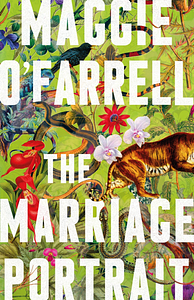Take a photo of a barcode or cover
Lucrezia de Medici grows up in her fathers Palazzo in Florence and is married of at a young age to the Duke of Ferrara, becoming the Duchess of Ferrara. The book has two time lines, in the first we follow our protagonist from earliest childhood and into her married life and in the other, she is visiting a remote location with her husband, sure that he plans to murder her.
The plot is very simple but has a satisfying ending that is tragic and hopeful at the same time.
The writing, as in Hamnet, is exquisite. It has a real ebb and flow that carries the reader along.
Lucrezia as a character was infuriating and sympathetic and interesting at the same time. I felt O'Farrell gave a real feel of what it was like for women of the period (especially upper class ones) who had no say at all in how they lived their lives and were completely at the mercy of their male relatives.
I liked this just as much as Hamnet, maybe even more. O'Farrell has a playbook. She takes a little known historical figure, fleshes them out and tells their story using two timelines, a dramatic event and her wonderful writing. I am a fan of this playbook - I'll read any novel she puts out next.
The plot is very simple but has a satisfying ending that is tragic and hopeful at the same time.
The writing, as in Hamnet, is exquisite. It has a real ebb and flow that carries the reader along.
Lucrezia as a character was infuriating and sympathetic and interesting at the same time. I felt O'Farrell gave a real feel of what it was like for women of the period (especially upper class ones) who had no say at all in how they lived their lives and were completely at the mercy of their male relatives.
I liked this just as much as Hamnet, maybe even more. O'Farrell has a playbook. She takes a little known historical figure, fleshes them out and tells their story using two timelines, a dramatic event and her wonderful writing. I am a fan of this playbook - I'll read any novel she puts out next.
reflective
tense
medium-paced
Plot or Character Driven:
A mix
Strong character development:
Complicated
Loveable characters:
Yes
Diverse cast of characters:
No
Flaws of characters a main focus:
Complicated
mysterious
medium-paced
Plot or Character Driven:
Character
Strong character development:
Yes
Loveable characters:
Complicated
Diverse cast of characters:
Complicated
Flaws of characters a main focus:
No
emotional
sad
tense
slow-paced
Plot or Character Driven:
Character
Strong character development:
Yes
Loveable characters:
Complicated
Diverse cast of characters:
No
Flaws of characters a main focus:
Yes
The Marriage Portrait is an imaginative work of historical fiction set in Renaissance Italy.
Author Maggie O’Farrell takes scant details about the life of Lucrezia di Cosimo de’Medici d’Este, Duchess of Ferrara, and her relationship with her husband, the Duke of Ferrara, to craft a harrowing tale about the power dynamics and the dangers that women faced in 16th century Italy.
After the tragic death of her older sister, Lucrezia is thrust into a rushed marriage with the Duke. Faced with prematurely navigating the liminal space between girlhood and adulthood, and adjusting to the life of a new noble home, she must face this ultimate question: Is her husband a caring and doting man, or is he trying to kill her? (Historical footnotes at the end of the book show that this was not an uncommon occurrence.) Lucrezia learns her value and security ultimately depend upon her ability, or inability, to provide an heir.
O’Farrell’s florid writing conveys a harrowing and heart wrenching story, a bit reminiscent of her previous work, Hamnet. True to its historical sources, The Marriage Portrait is tragic yet suspensefully alluring. Ultimately, it is a window into a world foreign to modern day, although the reader may find familiarity in the harm caused by power.
The Marriage Portrait should appeal to readers of historical fiction, literary works and tragic tales.
Originally published in The Northern Light
Author Maggie O’Farrell takes scant details about the life of Lucrezia di Cosimo de’Medici d’Este, Duchess of Ferrara, and her relationship with her husband, the Duke of Ferrara, to craft a harrowing tale about the power dynamics and the dangers that women faced in 16th century Italy.
After the tragic death of her older sister, Lucrezia is thrust into a rushed marriage with the Duke. Faced with prematurely navigating the liminal space between girlhood and adulthood, and adjusting to the life of a new noble home, she must face this ultimate question: Is her husband a caring and doting man, or is he trying to kill her? (Historical footnotes at the end of the book show that this was not an uncommon occurrence.) Lucrezia learns her value and security ultimately depend upon her ability, or inability, to provide an heir.
O’Farrell’s florid writing conveys a harrowing and heart wrenching story, a bit reminiscent of her previous work, Hamnet. True to its historical sources, The Marriage Portrait is tragic yet suspensefully alluring. Ultimately, it is a window into a world foreign to modern day, although the reader may find familiarity in the harm caused by power.
The Marriage Portrait should appeal to readers of historical fiction, literary works and tragic tales.
Originally published in The Northern Light
dark
emotional
mysterious
sad
tense
medium-paced
Plot or Character Driven:
Character
Strong character development:
Yes
Loveable characters:
Yes
Diverse cast of characters:
No
Flaws of characters a main focus:
Complicated
I quite enjoy a historical fiction that reexamines historical figures. The imagining of a life for Lucrezia de’ Medici were she is maneuver through an arranged and unhappy marriage gives an insight as to what life could have been life-- wealthy, sure, but smothered by the trappings of a patriarchal society where an unhappy husband could mean the death of you.
Read to get a insight into Renaissance Florence. I suppose it achieved that, but I just didn't like the writing. Felt like a lot of build up for not much action.
Great for fans of Circe and The Seven Or Eight Deaths Of Stella Fortuna
adventurous
dark
mysterious
slow-paced
Plot or Character Driven:
Character
Strong character development:
Complicated
Loveable characters:
Yes
Diverse cast of characters:
Complicated
Flaws of characters a main focus:
Yes






